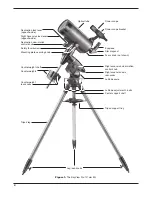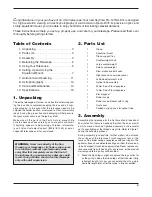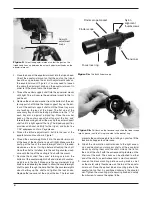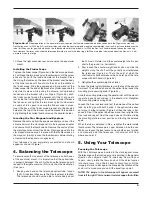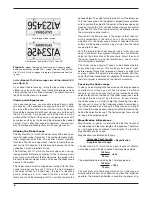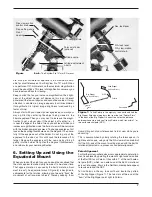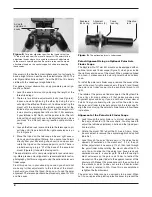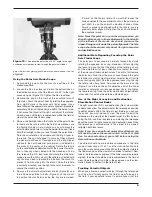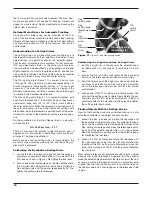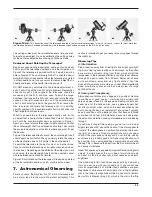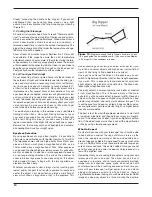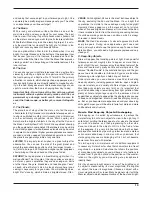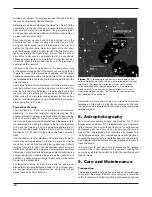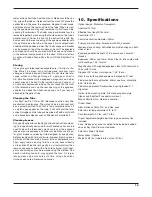
5
10. Place the right ascension rear axis cover on the equatorial
mount.
installing the Finder scope
To place the finder scope (Figure 3a) in the finder scope brack‑
et, unthread the two black nylon thumbscrews until the screw
ends are flush with the inside diameter of the bracket. Place
the O‑ring that comes on the base of the bracket over the body
of the finder scope until it seats into the slot on the middle of
the finder scope. Slide the eyepiece end (narrow end) of the
finder scope into the end of the bracket’s cylinder opposite the
adjustment screws while pulling the chrome, spring‑loaded
tensioner on the bracket with your fingers (Figure 3b). Push
the finder scope through the bracket until the O‑ring seats
just inside the front opening of the bracket cylinder. Release
the tensioner and tighten the two black nylon thumbscrews
a couple of turns each to secure the finder scope in place.
Insert the base of the finder scope bracket into the dovetail
holder on the top of the focuser. Lock the bracket into position
by tightening the knurled thumbscrew on the dovetail holder.
inserting the star Diagonal and Eyepiece
Remove the dust cap from the eyepiece adapter and insert the
chrome barrel of the star diagonal into the eyepiece adapter
and secure it with the thumbscrews. Remove the dust cap from
the star diagonal and insert the 25mm Plössl eyepiece into the
star diagonal and secure it in place with the thumbscrews on
the diagonal. (Always loosen the thumbscrews before rotating
or removing the diagonal or an eyepiece.)
Your telescope is now completely assembled and should
appear as shown in Figure 1.
4. Balancing the telescope
To ensure smooth movement of the telescope on both axes
of the equatorial mount, it is imperative that the optical tube
is properly balanced. We will first balance the telescope with
respect to the right ascension (R.A.) axis, then the declination
(Dec.) axis.
1. Keeping one hand on the telescope optical tube, loosen
the R.A. lock lever. Make sure the Dec. lock lever is locked.
The telescope should now be able to rotate freely about
the R.A. axis. Rotate it until the counterweight shaft is par‑
allel to the ground (i.e., horizontal)
2. Now loosen the counterweight lock knobs and slide the
weights along the shaft until they exactly counterbalance
the telescope (Figure 4a). That’s the point at which the
shaft remains horizontal even when you let go of the tele‑
scope with both hands (Figure 4b).
3. Retighten the counterweight lock lever.
Loosen the metal safety thumbscrew on the top of the equato‑
rial mount. Then with one hand on the optical tube, loosen the
mounting plate securing knob. (Figure 4c)
Slide the mounting plate along the dovetail slot until the mount‑
ing plate is positioned midway in the dovetail slot. Retighten
the mounting plate securing knob.
Loosen the Dec. lock lever and test the balance of the optical
tube by letting go with both hands. If the optical tube does
not move in either direction (Figure 4d) then the tube is bal‑
anced in Dec. If the optical tube does move, then retighten the
Dec. lock and repeat from the step 4 above, this time sliding
the mounting plate to a new position and testing the balance
again.
When the tube is balanced in Dec., retighten the metal safety
thumbscrew. The telescope is nopw balanced in both axes.
When you loosen the lock lever on one or both axes of motion
and manually point the telescope, it should not drift from
where you point it.
5. using Your telescope
Focusing the telescope
With the 25mm eyepiece inserted in the star diagonal, move
the telescope so the front (open) end is pointing in the general
direction of an object at least 1/4‑mile away. Now, with your
fingers, slowly rotate the focus knob until the object comes
into sharp focus. Go a little bit beyond sharp focus until the
image just starts to blur again, then reverse the rotation of the
knob, just to make sure you’ve hit the exact focus point.
NOTE: The image in the telescope will appear reversed
from left to right. This is normal for telescopes that utilize
Figure 4a‑d.
Proper operation of the equatorial mount requires that the telescope tube be balanced on both the Right ascension and
Declination axes. (a) With the R.A. lock lever released, slide the counterweights along the counterweight shaft until it just counterbalances the
tube. (b) When you let go with both hands, the tube should not drift up or down. (c) With the Dec. lock knob released, loosen the tube ring
lock clamps a few turns ands slide the telescope forward or back in the tube rings. (d) When the tube is balanced about the Dec. axis, it will
not move when you let go.


